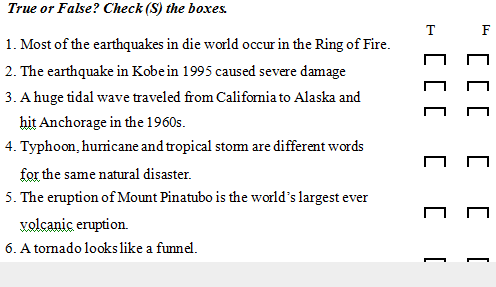Earthquakes: Ninety percent of earthquakes occur around the Pacific Rim,\r\nwhich is known as the ‘Ring of Fire’. In 1995, a huge earthquake struck the city of Kobe in Japan. A large number of people were killed when homes, office blocks and highways collapsed.
Earthquakes: Ninety percent of earthquakes occur around the Pacific Rim,
which is known as the ‘Ring of Fire’. In 1995, a huge earthquake struck the city of Kobe in Japan. A large number of people were killed when homes, office blocks and highways collapsed.
Tidal waves: Tidal waves are the result of an abrupt shift in the underwater movement of
die Earth. In the 1960s, a huge tidal wave hit Anchorage, Alaska. The tidal wave traveled
from Alaska to California!
Typhoons: When a tropical storm reaches 120 kilometers per hour, it is called a hurricane in North and South America, a cyclone in Australia, and a typhoon in Asia. The word ‘typhoon' comes from Chinese: tai means ‘big’ and feng means ‘wind’, so the word ‘typhoon’ means ‘big wind’.
Volcanoes: We can usually predict when a volcano will erupt. Mount Pinatubo, which
is a volcano in the Philippines, erupted in 1991. It was the world’s largest volcanic eruption in more than 50 years. Hundreds of people died, but thousands were saved because scientists had warned them about the eruption.
Tornadoes: Tornadoes are funnel-shaped storms which pass overland below a thunderstorm. They can suck up anything that is in their path. In Italy in 1981, a tomado lifted a baby, who was asleep in its baby carriage, into the air and put it down safely 100 meters away!
Đọc
Động đất: 90% cuộc động đất xảy ra quanh vòng đai Thái Bình Dương được - biết như là “Vòng đai lửa". Năm 1995. vụ động đất dữ dội làm sập thành phố Kobe ở Nhật. Rất nhiều người chết khi nhà cứa, cao ốc văn phòng và xa lộ sụp đổ.
Sóng thần : Sóng thần là hậu quá của sự chuyển dịch thinh lình của sự chuyên động dưới nước cùa trái đấi. Vào thập niên 1960, một ngọn sóng thần khổng lồ đập vào Anchorage, Alaska. Cơn sóng thần di chuyển từ Alaska đến California!
Cuồng phong : Khibão nhiệt đới đạt đến 120 cây sô một giờ, nó được gọi là bão (cấp

Núi lửa : Chúng ta thường thường cỏ thể tiên đoán khi nào núi lứa phun. Ngọn Pinalubo, ngọn núi lứa ở Phi-líp-pin. phun năm 1991. Đỏ là vụ phun núi lửa lớn nhất thế giới trong vòng hơn 50 năm. Hàng trăm người chết, nhưng hàng ngàn người được cứu vì các nhà bác học đã cành giác họ về vụ phun.
Bão xoáy : Bão xoáy là những cơn bào có hình phễu đi qua đất liền dưới dạng cơn bão có sấm sét. Chúng hút bất kì vật gì trên đường đi. Năm 1981 ở Ý, một cơn bão xoáy bốc một em bé đang ngù trong xe nôi lên không và bỏ xuống an toàn cách xa 100 cây số’.

True or False? Chech (✓) the boxes. (Đúng hay Sai? Đánh dấu (✓) vào ô.)
T F
Most of the earthquakes in the world occur in the Ring of Fire. ✓
The earthquake in Kobe in 1995 caused severe damage. ✓
A huge tidal wave traveled from Alaska to California and ✓
hit Anchoragein 1960s.
4. Typhoon, hurricane and tropical storm are different ✓
words for the samp natural disaster.
5. The eruption of Mount Pinatubo is the world’s largest ✓
ever volcanic eruption.
6. A tornado looks like a funnel.
2. Complete the sentences.
The majority of earthquakes ... .
During the earthquake in Kobe, many ... .
A tidal wave can only occur when ... .
In Ausfralia, a tropical storm is known as ... .
The Chinese language gave us ... .
A tomado is a type of storm that..........
2. Complete the sentences, (Hoàn thành các câu.)
The majority of earLliquakt-s occur around the Pacific Rim, known as a Ring of Fire.
During the earthquake in Kobe, manv houses, office buildings and highways collapsed
A tidal wave can only occurs when there’s an abrupt shift in the underwater movement of the earth.
In Austtralia, a tropical storm is known as a cyclone.
The Chinese language gave us the word “typhoon”.
A tornado is a type of storm that has a funnel shape and sucks up anything in its way.

